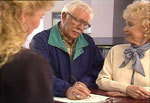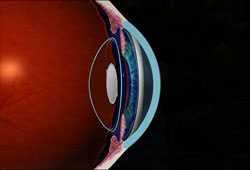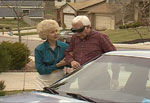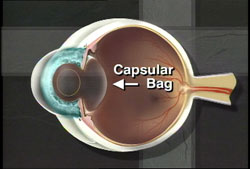Cataract Surgery
 Over fifty percent of people over the age of 60, and quite a few younger than that, suffer from cataracts. Currently there is no medical treatment to reverse or prevent the development of cataracts. Once they form, the only way to see clearly again is to have them removed from within the eye.
Over fifty percent of people over the age of 60, and quite a few younger than that, suffer from cataracts. Currently there is no medical treatment to reverse or prevent the development of cataracts. Once they form, the only way to see clearly again is to have them removed from within the eye.
In your parents’ or grandparents’ day, cataract surgery was considered risky, required a lengthy hospital stay and was usually postponed for as long as possible. Today, cataract surgery is performed on an outpatient basis and takes only a few minutes. It is now one of the most common and successful medical procedures performed. In fact, following cataract surgery, many patients experience vision that is actually better than what they had before they developed cataracts.
Cataract surgery is for those who:
- believe that their quality of life has been impaired by poor vision
- have been diagnosed with cataracts
- have no health issues affecting their eyes
What to expect on surgery day:
 You will arrive at the surgery center about an hour prior to your procedure. Once you have been checked in you may be offered a sedative to help you relax. You will then be prepared for surgery. The area around your eyes will be cleaned and a sterile drape may be applied around your eye.
You will arrive at the surgery center about an hour prior to your procedure. Once you have been checked in you may be offered a sedative to help you relax. You will then be prepared for surgery. The area around your eyes will be cleaned and a sterile drape may be applied around your eye.

Your eye will be completely numbed before the procedure.
Eye drops or a local anesthetic will be used to numb your eyes. When your eye is completely numb, an eyelid holder will be placed between your eyelids to keep you from blinking during the procedure.
Advanced Eye Care Center now performs LenSx® Laser Assisted Cataract Surgery. During LenSx® Laser Assisted Cataract Surgery The LenSx® femtosecond laser is used to perform many of the surgical steps that were traditionally performed by hand. The precise, reproducible steps performed by the laser mean better lens positioning, less trauma to the eye, and more predictable visual results which are especially important with premium IOL implants.
To begin, a stair-step incision is created on the edge of the cornea with the laser instead of with a blade. The incision is self-sealing and rarely needs suturing.
The laser then creates an opening, “capsulorhexis”, in the thin capsular membrane that surrounds the natural lens to provide an opening to remove the cataract. Studies have shown that less than 10% of manual capsulorhexi, which are made with a bent or shaped needle, have been able to achieve the same accuracy that is produced with laser cataract surgery.
The laser also softens the nucleus as it is divided into manageable pieces, thereby allowing the cataract to be removed using less ultrasound energy. This is beneficial because there is less inflammation during surgery, making the procedure less traumatic to the eye.
Next a folded intra-ocular lens (IOL) will be inserted through the micro-incision, then unfolded and locked into permanent position. The small incision is “self-sealing” and usually requires no stitches. It remains tightly closed by the natural outward pressure within the eye. This type of incision heals fast and provides a much more comfortable recuperation.

Intra-Ocular Lens replaces the natural lens of the eye.

The IOL is placed inside the capsular bag of the eye.
If your eye has pre-existing astigmatism, your surgeon may elect to reduce or eliminate your astigmatism at the time of cataract surgery by implanting a Toric Intraocular lens or by performing micro-incisions on the cornea
called LRIs or limbal relaxing incisions.

Pre-existing astigmatism can be treated with limbal relaxing incisions.
The need for eyeglasses for both distance and reading vision can be reduced or eliminated at the time of cataract surgery with new technology Presbyopia Correcting Intraocular Lens Implants such as TECNIS® Symfony IOL, the TECNIS® Multifocal IOL and the Crystalens® Accommodating IOL
 You will go home soon after the surgery and relax for the rest of the day. Everyone heals somewhat differently, but many patients report improvement in their vision almost immediately after the procedure. Most patients return to their normal activities within a day or two.
You will go home soon after the surgery and relax for the rest of the day. Everyone heals somewhat differently, but many patients report improvement in their vision almost immediately after the procedure. Most patients return to their normal activities within a day or two.
Realistic expectations:
The decision to have cataract surgery is an important one that only you can make. The goal of any vision restoration procedure is to improve your vision. However, we cannot guarantee you will have the results you desire.
Once removed, cataracts will not grow back. But some patients may experience clouding of a thin tissue, called the capsular bag, that holds the intra-ocular lens. In most cases, a laser is used to painlessly open the clouded capsule and restore clear vision with a procedure called a capsulotomy.

The capsular bag may become cloudy in the future.
Serious complications with cataract surgery are extremely rare. It is a safe, effective and permanent procedure, but like any surgical procedure, it does have some risks. Going to an eye specialist experienced with the procedure can significantly minimize the risks involved with cataract surgery.
After a thorough eye exam, you and your doctor will determine if cataract surgery is an option for you. You will be given additional information about the procedure that will allow you to make an informed decision about whether to proceed. Be sure you have all your questions answered to your satisfaction.
You may also choose to make an appointment or request additional information to learn more about this exciting procedure.


